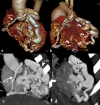Coronary artery fistulas detected with coronary CT angiography: a pictorial review of 73 cases
- PMID: 31638419
- PMCID: PMC7362926
- DOI: 10.1259/bjr.20190523
Coronary artery fistulas detected with coronary CT angiography: a pictorial review of 73 cases
Abstract
Coronary artery fistulas (CAFs) are abnormal connections of the coronary arteries that bypass the myocardial capillary bed and terminate into chambers of the heart or major blood vessels. CAFs are rare, and most of them are congenital. Because CAFs can be asymptomatic and detected incidentally, the true incidence is difficult to evaluate. CAFs usually have various and complicated image features, and the clinical symptoms mainly depend on the size, origin and drainage site of the fistulas. Thus, accurate imaging assessment of these characteristics is crucial for therapeutic planning and post-operative evaluation. Due to the high temporal and spatial resolution, coronary CT angiography has recently become more widely used in cardiovascular disease diagnosis, and more asymptomatic CAFs are accidentally found. Furthermore, with multiplanar reconstruction images, some complicated and subtle structures can be displayed more accurately. In this article, we reviewed the imaging features of CAFs on coronary CT angiography, mainly focusing on the pre- and post-operative anatomy displaying of these abnormalities.
Figures








References
-
- Krause W. Uber den ursprung einer accessorischen A. coronaria AUS Der A. pulmonalis. Z Ratl Med 1865; 24: 225–7.
MeSH terms
LinkOut - more resources
Full Text Sources
Medical

